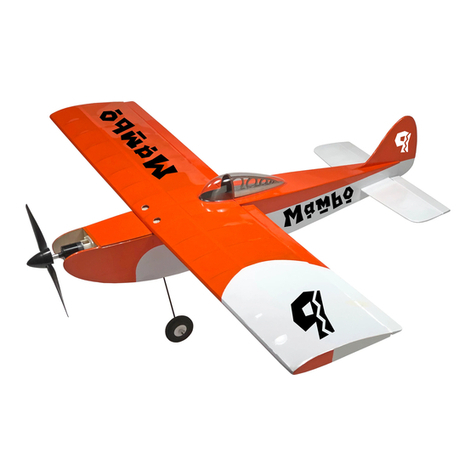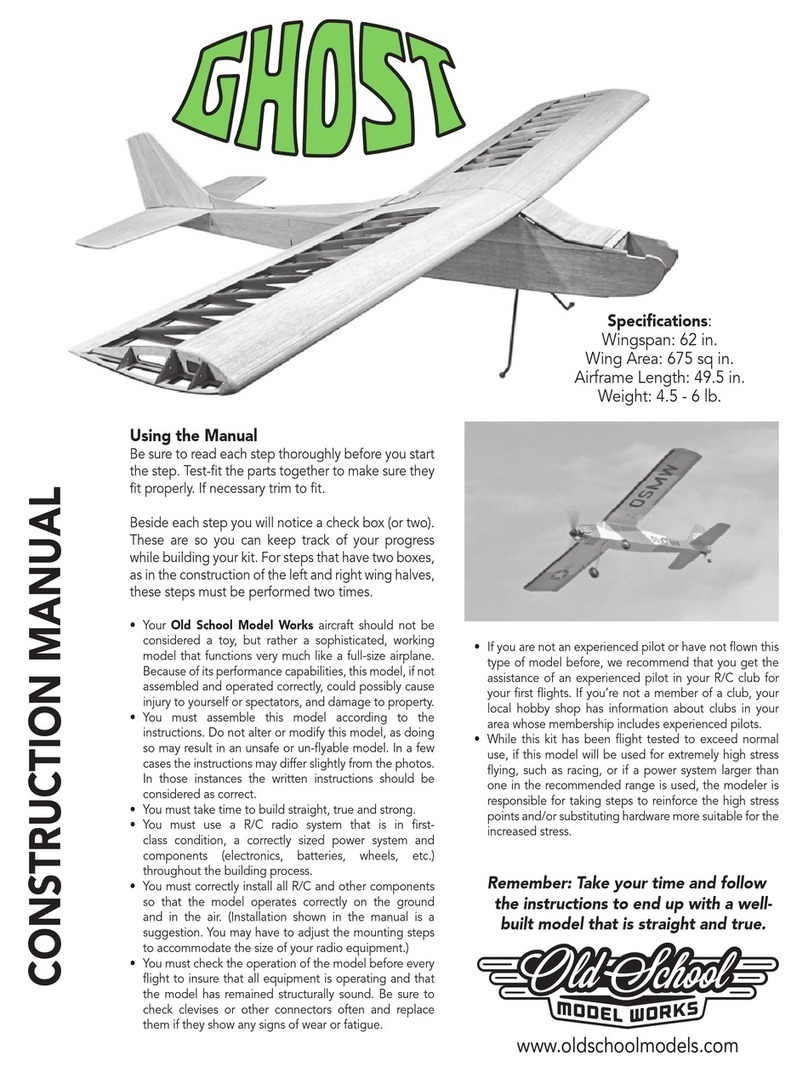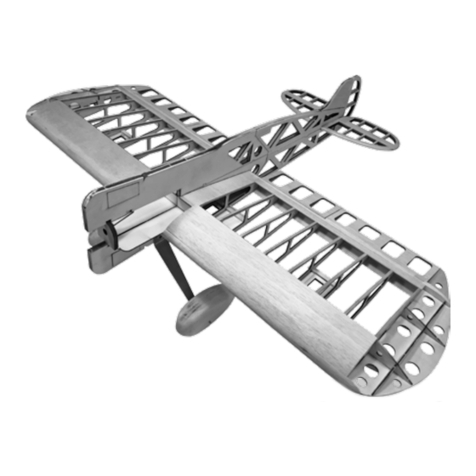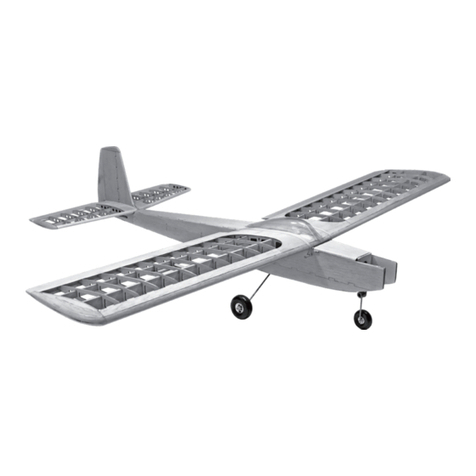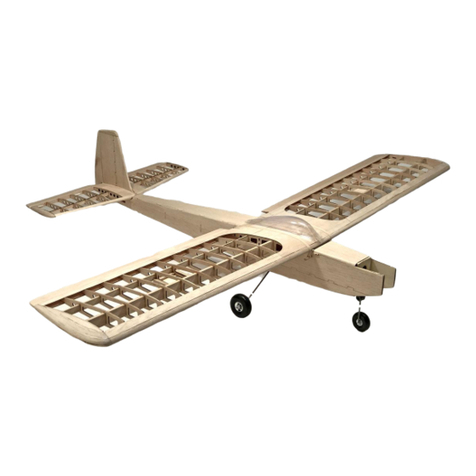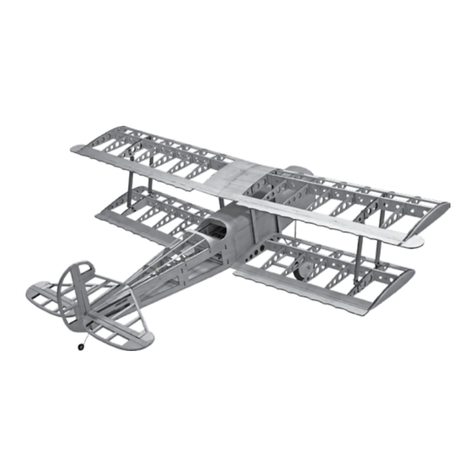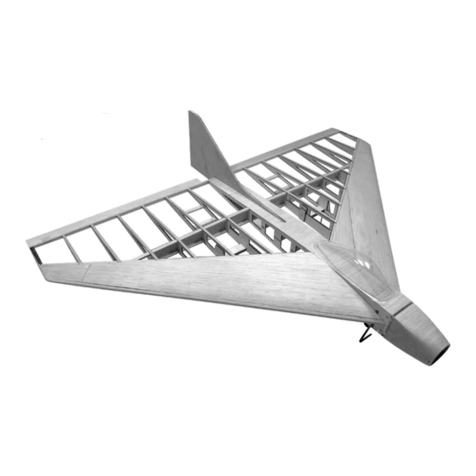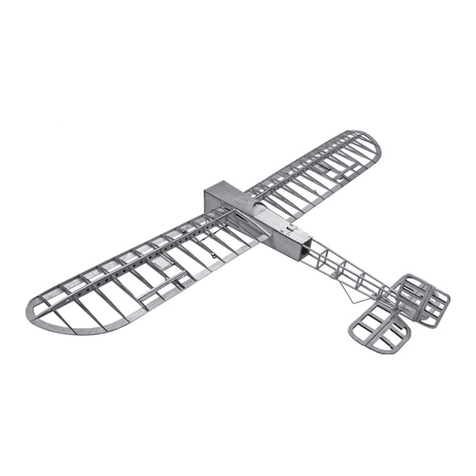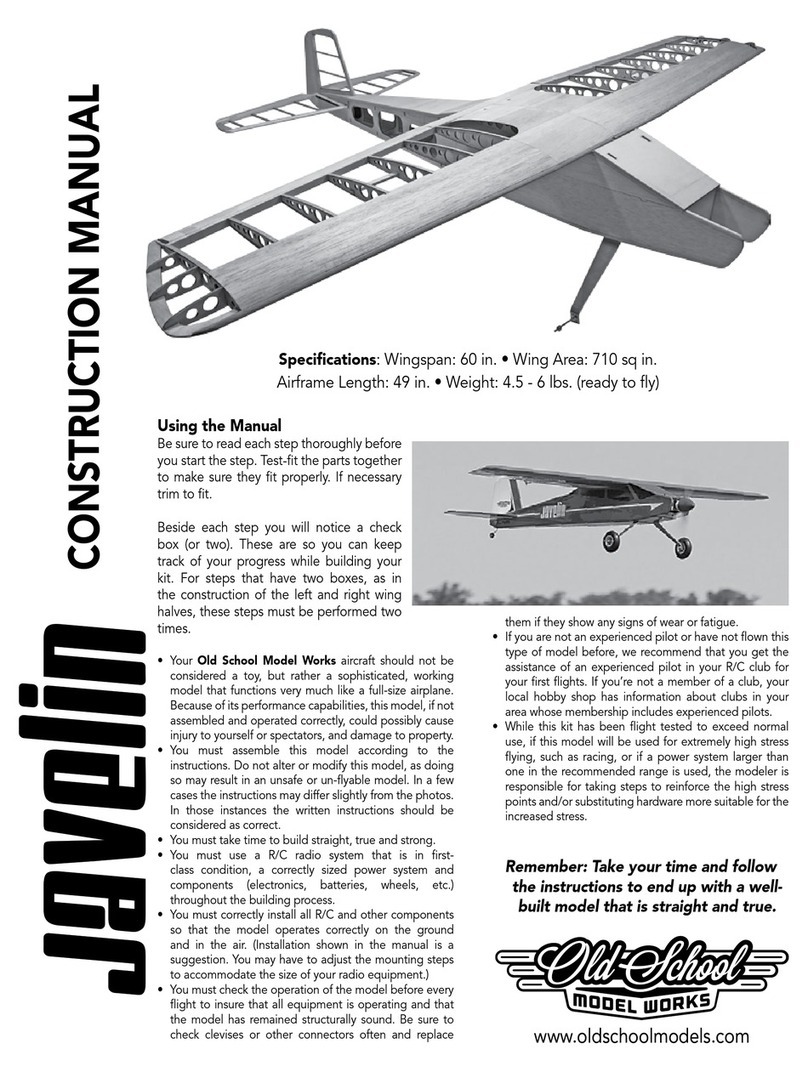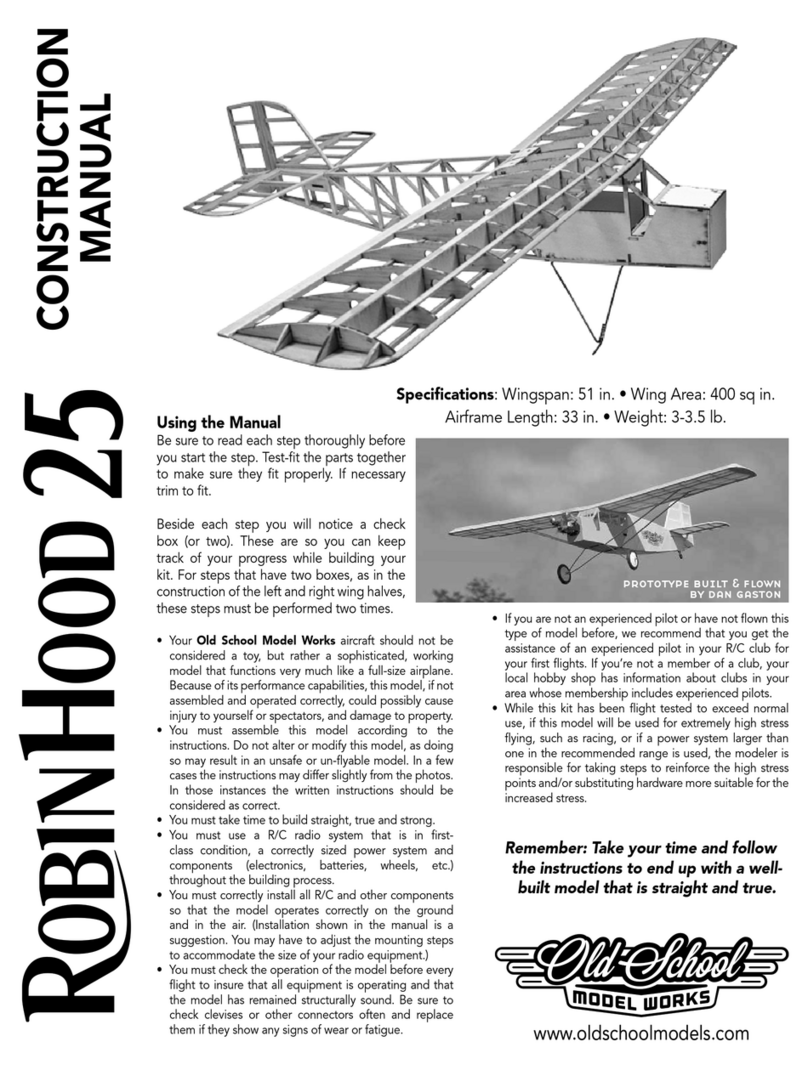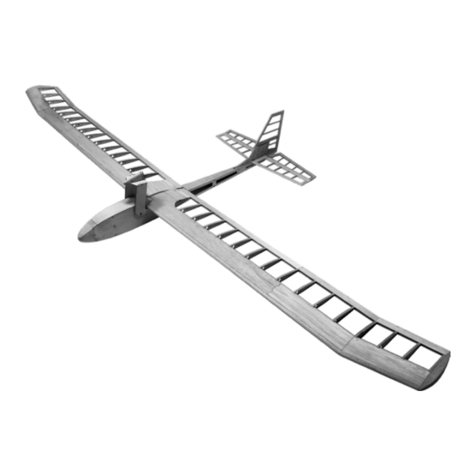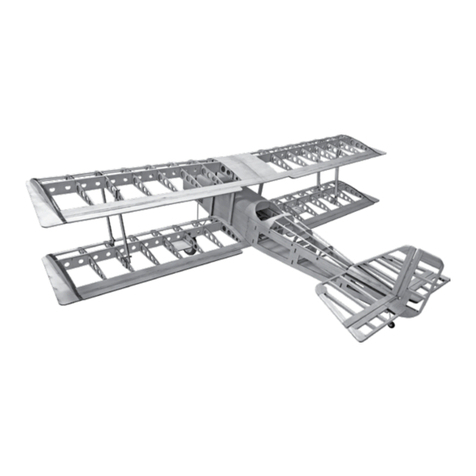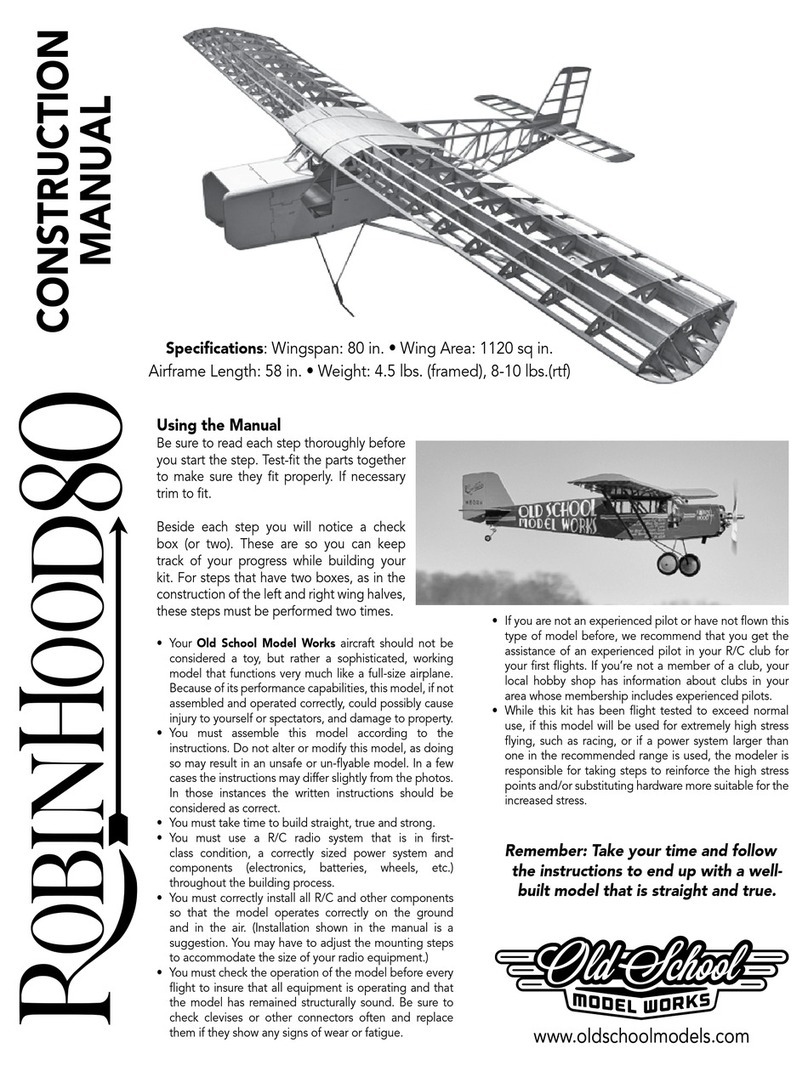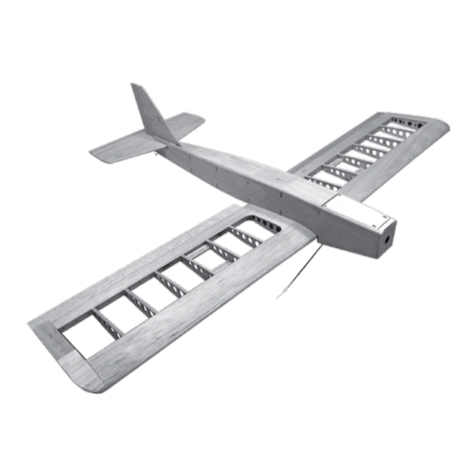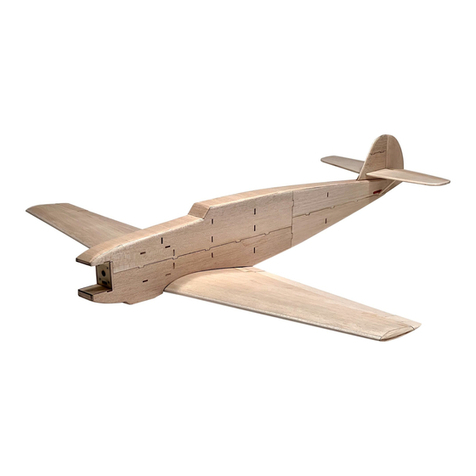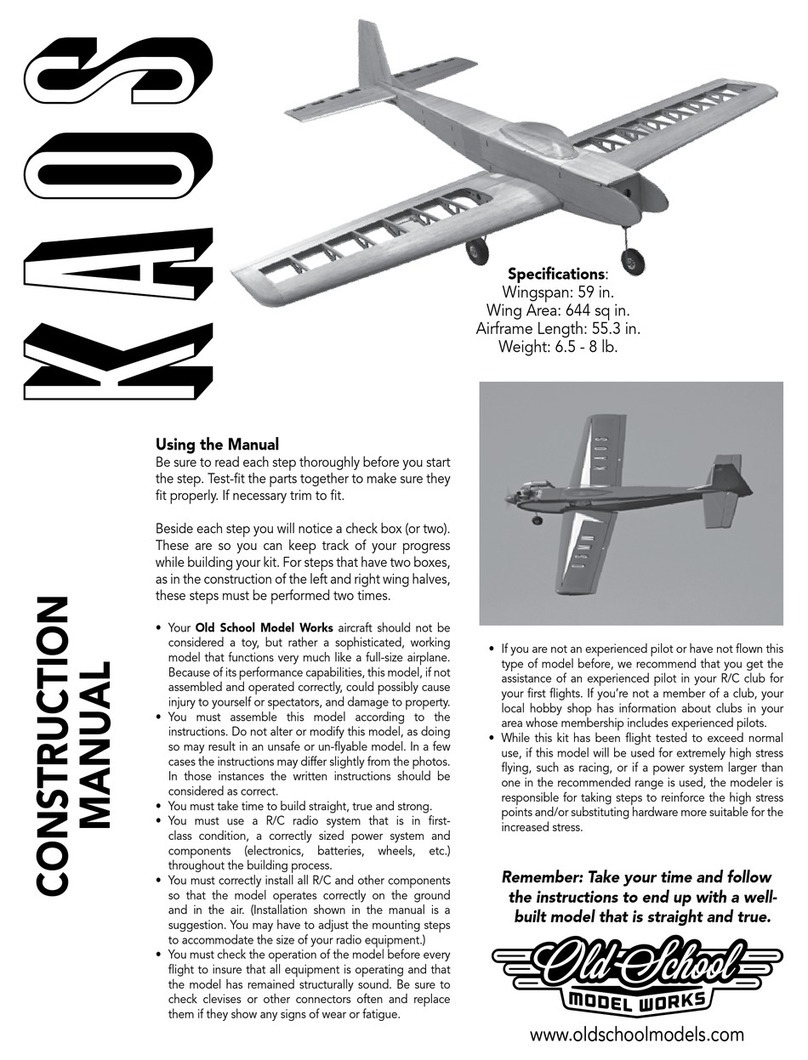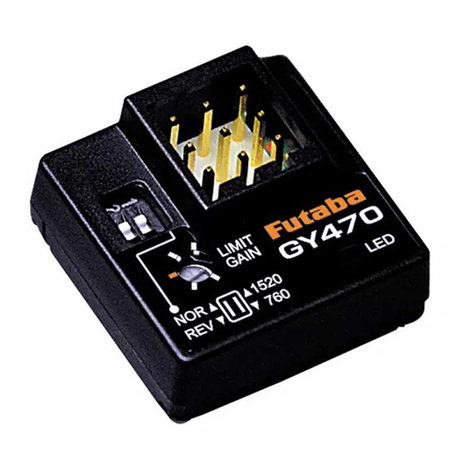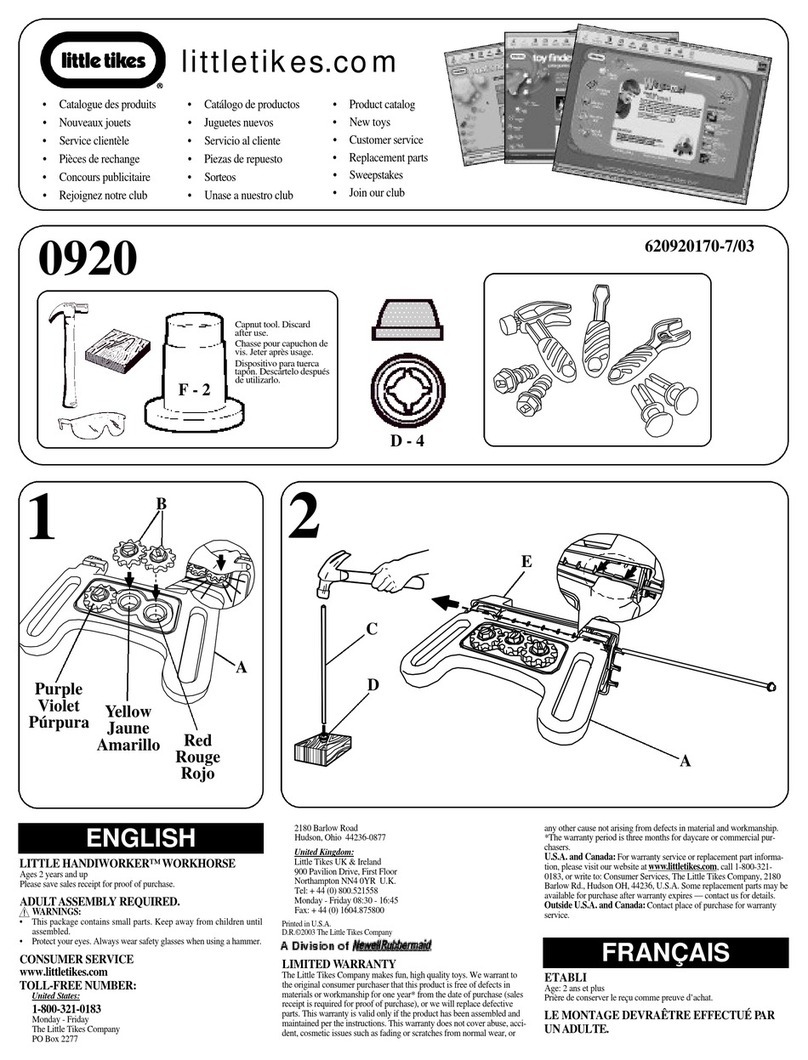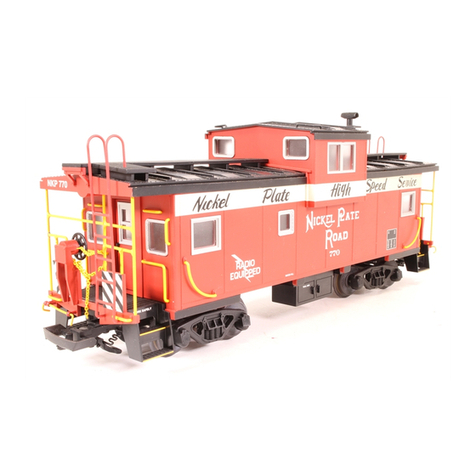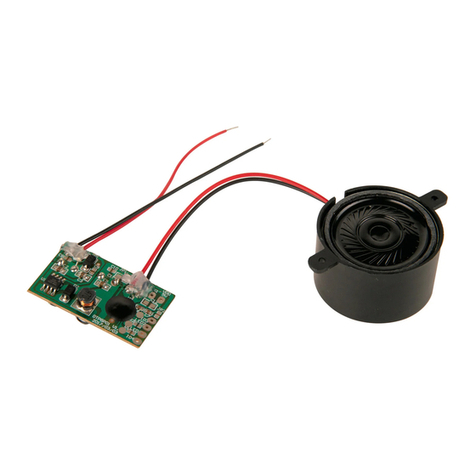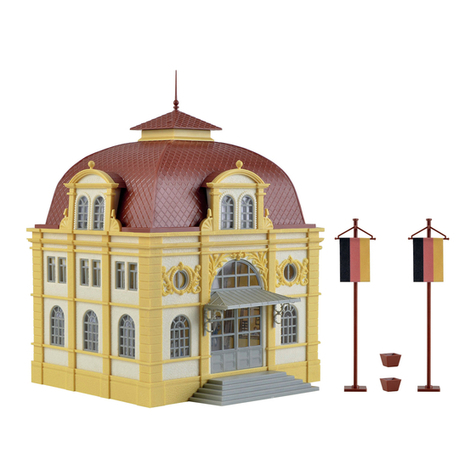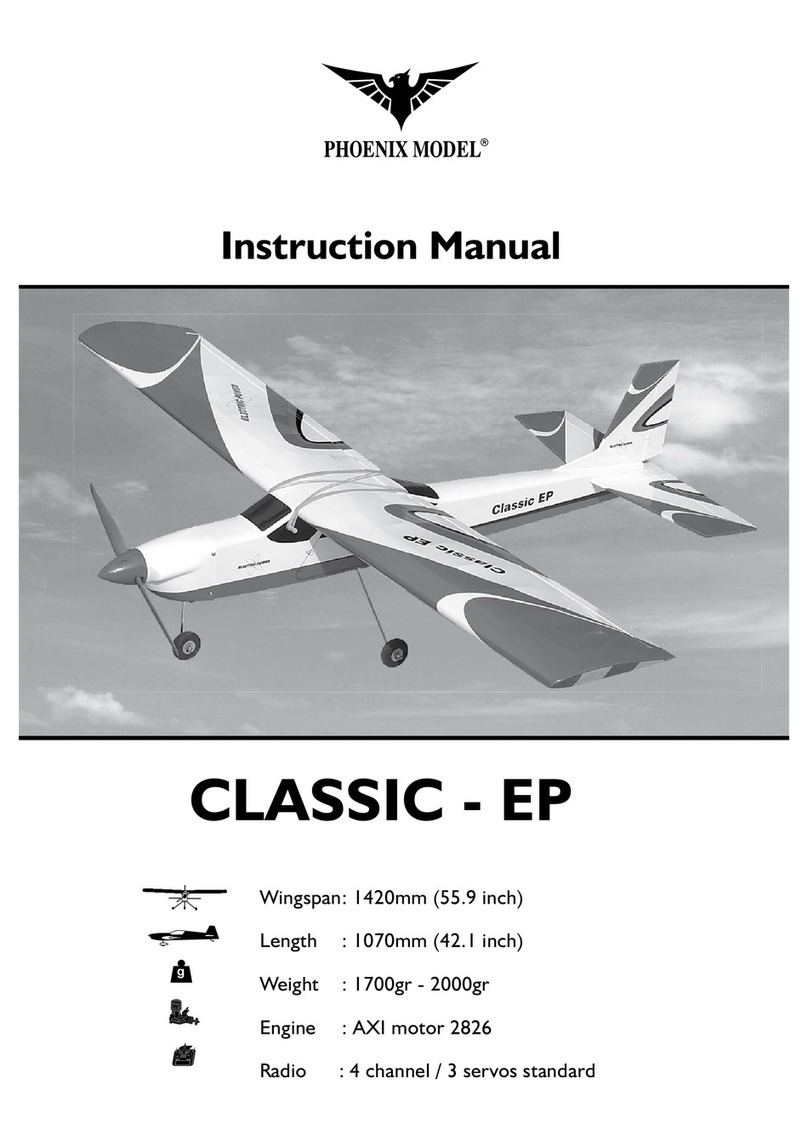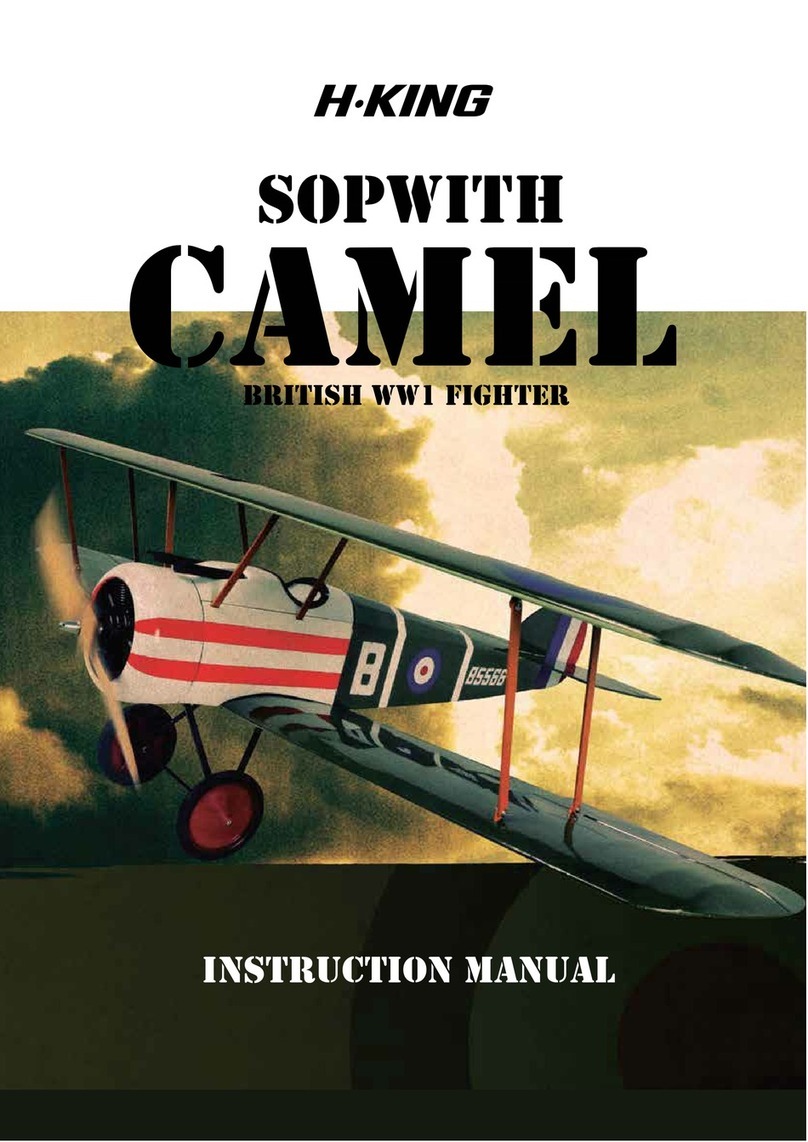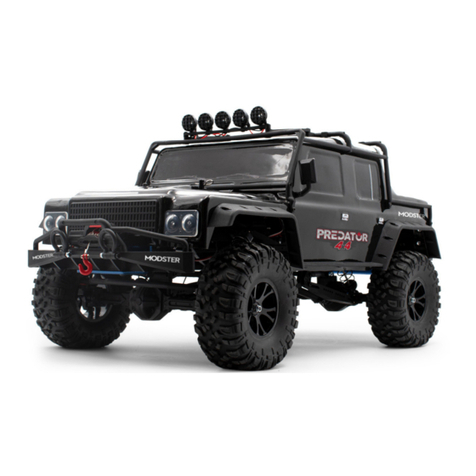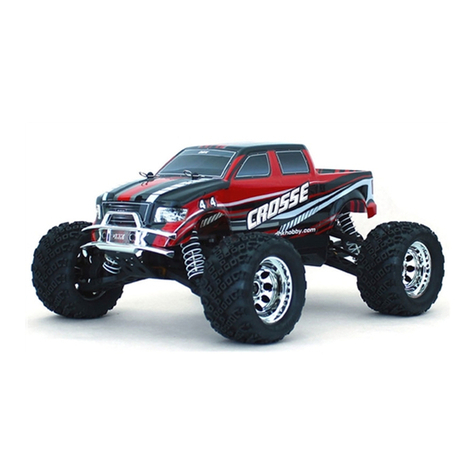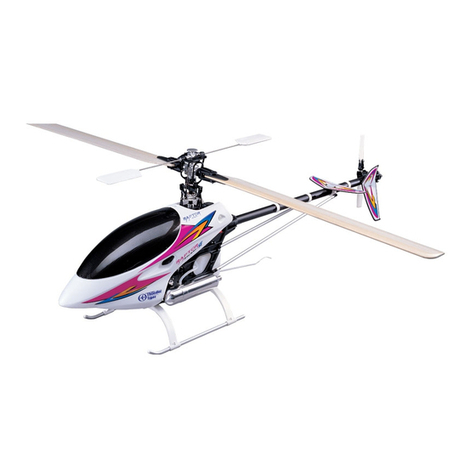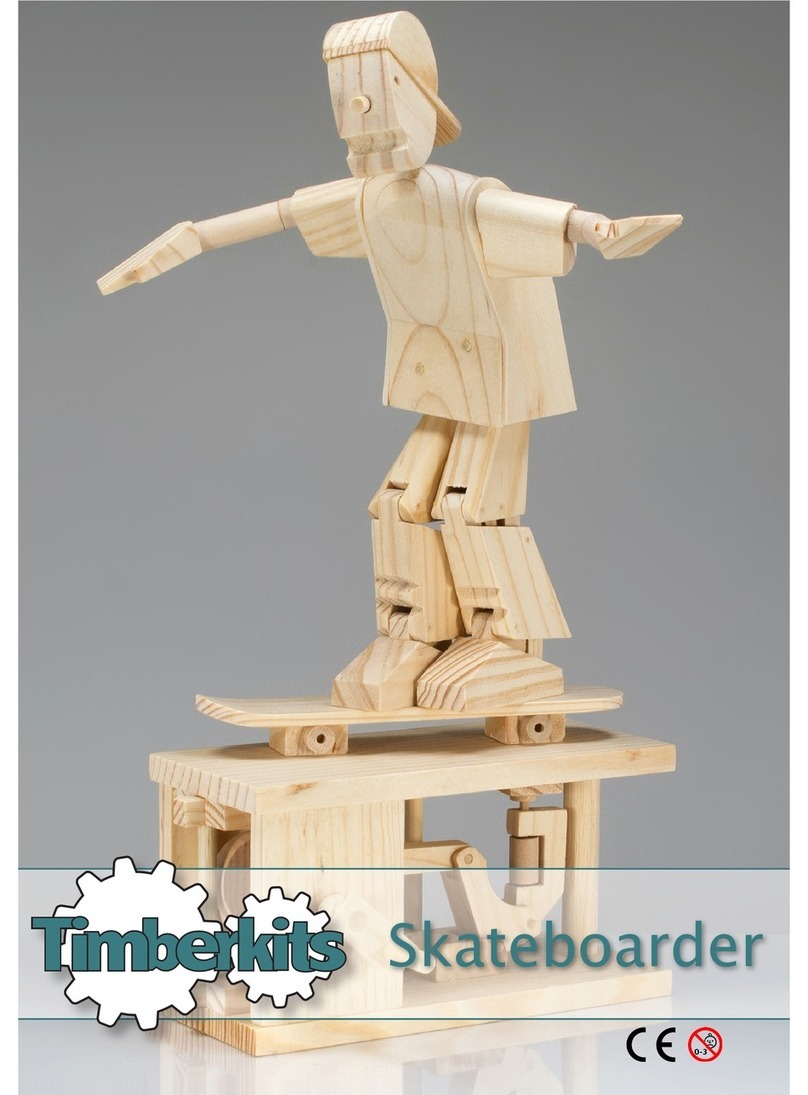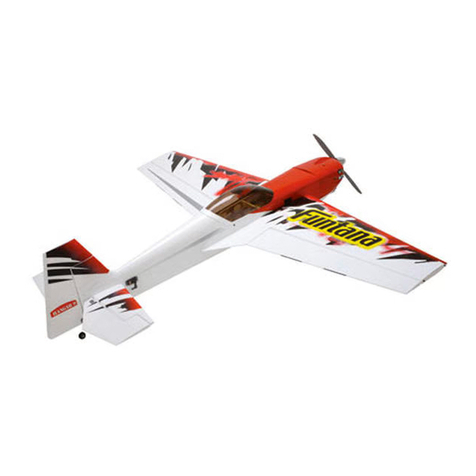
Page 6 www.oldschoolmodels.com Construction Manual
helps). CS3 has purposely been cut
a little long, so you'll need to trim
it to get a perfect fit filling the gap
between CS1 and CS2.
Also note that CS3 has a pre-cut hole in
it. This is to allow the aileron servo wire
to exit. This hole should be positioned
so it’s closer to the root rib (R1).
When satisfied with how it all looks,
remove the pieces and it’s time to
glue them together into a single sheet.
When edge gluing the sheeting pieces together, first make sure
the edges are flat (give a quick, swipe or two with a sanding block).
Then tape the two pieces together with a piece of masking tape.
As you lift the sheeting from the board you’ll see that the tape will
act as a hinge allowing you to put a small amount of adhesive into
the joint. When the adhesive is applied, place the sheeting back
down on the waxed paper, so that it’s flat and apply pressure to
the joint while it cures to make sure it’s flat along it’s entire length.
When cured, you’ll now have a single, longer piece of sheeting.
It’s easier to join the shorter lengths
of sheeting together on a flat
surface. Then when the glue has
cured, glue the sheeting in place
on the wing. Start at the leading
edge and gluing a little at a time.
Press the sheeting firmly against
the ribs and wait for the glue to
cure before gluing the next section
of sheeting - slowly working your way back to the trailing edge,
being careful not to put a bend (warp) in the wing.
n n Step 25 - Wing Assembly (TE)
Locate one TE from BP14. This is
the trailing edge sheeting. Glue
this in place into the “groove”
pre-cut into the rear of each rib as
shown here. Be sure it is glued to
each of the ribs, to the top of the
trailing edge and to the center
sheeting you just applied.
n n Step 26 - Wing Assembly (LE)
Locate one LE from BP14. This is
the leading edge sheeting. Glue
this in place into the “groove”
pre-cut into the front of each
rib as shown here. Be sure it is
glued to each of the ribs and to
the leading edge, and the center
sheeting.
As the sheeting we get can vary in density, you might have to apply
a bit of Windex® glass cleaner to loosen up the grain and allow
it to bend without cracking. Soak the outer side of the wood to
expand the fibers. Now hold it to curvature needed, then use a
hair dryer or covering heat-gun to help “set” the balsa’s bend as it
dries. Once dry, then you can glue it in position.
n n Step 27 - Wing Assembly (remove under-side tabs)
Once the glue has cured it’s time to carefully remove the wing
assembly from the board. Once removed, flip it over and it’s time
to remove all the underside tabs that helped hold the ribs in place.
There’s one in the front and one in the back of each rib. On ribs
R2-R7, these are balsa and easily cut away with a hobby knife. R1
ribs are lite ply and might need a bit more persuasion to remove.
When trimming these tabs, make sure you cut them away just
enough so that the airfoil shape of each rib is not interrupted. On
the trailing edge, this will mean that each tab will be cut away so
the trailing edge sits 1/16” proud of each rib.
n n Step 28 - Wing Assembly (LG1, LG2)
Locate one LG1 and three LG2s from
LP1, LP5 and LP6.
The three LG2s are glued together,
one on top of the other. Make sure that
their pre-cut holes are lined up, and
the three pieces are perfectly aligned
while the glue cures.
Now LG1 is glued to this LG2 assembly.
Before gluing in place, note that the
slot in LG1 is offset and the end of that
slot will align with the hole in LG2, only if correctly positioned. When you
know how it correctly aligns, apply glue to the back side of LG1, then glue
it in position, making sure to keep excess glue out of LG1's slot.
Finally, test fit the LG assembly into the pocket between R2 and R4. Lightly
sand LG's edges as necessary to insure a good fit, then glue it in position.
Make sure it is fully inserted and resting on the cutouts of the R2A and
R4A pieces.
n n Step 29 - Wing Assembly (wing dowels)
Locate the 6” length of 1/4” dowel from the
hardware bag. Cut it in half and round one end
of each dowel, as shown in the photo. An easy
way to do it is to chuck the dowel into a drill,
then spin it against sandpaper, rounding it to a
nice shape.
Now mark and cut a hole into the leading
edge of the wing where the dowel should
be inserted, making sure it is centered on
the leading edge strip. Cut the hole a bit
undersized, then gradually enlarge it until
you get a nice, snug fit. Test fit the dowel
and make sure that it also slips through the
internal WH1 piece.
Place glue on the lower part of the dowel and insert the dowel
through the leading edge and into WH1, leaving approximately
1/3”-1/2" of the dowel exposed.
n n Step 30 - Wing Assembly (CS1, CS2, CS4)
Locate one CS1 one CS2 and one
CS4 from BP15, and one CS6 from
LP7. These are used to create the
center sheeting for the underside of
the wing.
Use the same techniques that you
used when forming the upper
sheeting a few steps back. You’ll
need to trim CS4 to fit between the
gap of the CS1 and CS2.
Also note that CS6 has a pre-cut hole in it. This is where the wing bolt will
go through to attach the wing later on. This hole should be positioned so
it’s closer to the root rib (R1). When this assembly is completed, glue it in
place using the same techniques as applying the top sheeting.
